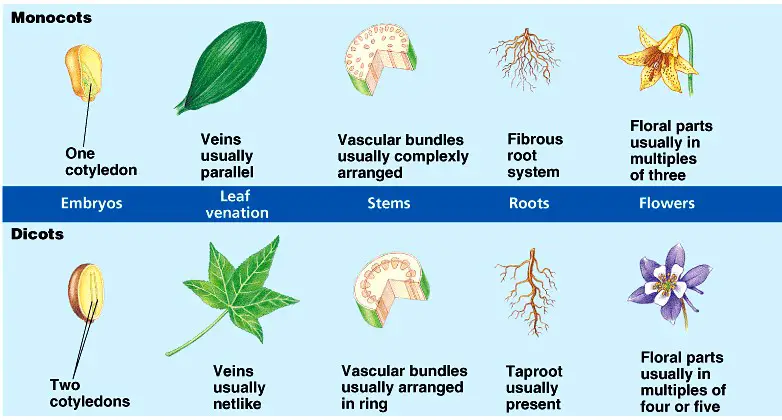This blog post will explore the differences between two types of flowering plants, eudicots and monocots. We will look at how these two types of plants are classified, their general characteristics, and the differences between them.
We will also examine how the two types of plants differ in their physical characteristics, growth patterns, and reproductive features. By the end of this post, you will have a better understanding of the differences between eudicots and monocots and why they are classified as such.
Comparison of eudicots and monocots

When it comes to the world of plants, there are two distinct types: eudicots and monocots. While both of these plant groups are classified as flowering plants, there are some key differences between them that set them apart. Eudicots, also known as dicots, have two seed leaves, or cotyledons, and typically have floral parts in multiples of four or five.
Eudicots, also known as dicots, have two seed leaves, or cotyledons, and typically have floral parts in multiples of four or five. Monocots, on the other hand, have only one seed leaf and usually have floral parts in multiples of three. Additionally, eudicots have a branching vascular system, while monocots have a parallel vascular system.
Finally, eudicots typically have netted veins in their leaves, while monocots have parallel veins. Knowing the differences between eudicots and monocots can help you better understand the world of plants.
Characteristics of eudicots

Eudicots are a large group of flowering plants that are distinguished by their unique characteristics. They are one of two major groups of flowering plants, the other being monocots.
Monocots have just one cotyledon in their seed, whereas eudicots have two. This difference is also reflected in other characteristics, such as the number of petals in a flower or the arrangement of veins in a leaf.
Eudicots tend to have flowers with four or five petals, and their leaves have a network of veins. Monocots have flowers with three petals, and their leaves typically have a parallel vein pattern. Eudicots also have a variety of fruit types, such as nuts, berries, and drupes, which are not found in monocots.
Eudicots also have a variety of fruit types, such as nuts, berries, and drupes, which are not found in monocots. In addition, eudicots typically have a wide range of root systems, from the shallow tap root of the carrot to the deep tap root of the dandelion. These characteristics make eudicots an incredibly diverse and interesting group of plants.
Characteristics of monocots

Monocots, or monocotyledons, are one of the two major groups of flowering plants. They are distinguished from the other major group, the eudicots, by having one cotyledon, or seed leaf, as opposed to the two cotyledons of the eudicots. Additionally, monocots have a variety of other characteristics, such as a fibrous root system, parallel veins in their leaves, and flower parts in multiples of three.
Additionally, monocots have a variety of other characteristics, such as a fibrous root system, parallel veins in their leaves, and flower parts in multiples of three. They are also typically grasses and other herbaceous plants, although some trees and shrubs are monocots too. These differences between monocots and eudicots make them easy to identify and classify.
Differences in root structure

When it comes to the root structure of plants, there is a distinct difference between eudicots and monocots. Eudicots have a taproot system, meaning the root of the plant grows downward and branches off into secondary and tertiary roots. Monocots, on the other hand, have a fibrous root system, where many thin, shallow roots grow outwards from the base of the plant.
This difference in root structure can affect how the plants grow and how they interact with their environment. For example, the taproot system of eudicots helps them to access nutrients and water from deeper in the soil, whereas the fibrous root system of monocots is better suited for taking up water and nutrients from the top layers of soil.
Differences in flower structure

When it comes to flowers, there are two main categories: eudicots and monocots. While they both may appear to be similar, upon closer inspection, there are significant differences in their structure and function. Eudicots have two cotyledons in their seed, which are the first leaves that emerge when a seed sprouts.
Additionally, eudicots have a flower with a bilateral symmetry, which means that it can be divided into two equal halves. The veins of eudicot leaves are typically net-like, which helps to provide the flower with even distribution of water and nutrients.
Monocots, on the other hand, have a single cotyledon in their seed. Monocot flowers have an asymmetrical structure, which means that they cannot be divided into halves, but instead have many different petals and sepals. The veins of monocot leaves are typically parallel, which helps the plant to quickly absorb water and nutrients.
The veins of monocot leaves are typically parallel, which helps the plant to quickly absorb water and nutrients. In summary, eudicots and monocots have distinct differences in their structure and function, from the number of cotyledons in their seed to the shape of their flowers.
Conclusion
In conclusion, the main difference between eudicots and monocots is the way in which their leaves, flowers, stems, and roots are arranged. Eudicots have two cotyledons, whereas monocots have only one. Eudicots have net-like venation patterns in their leaves, whereas monocots have parallel venation patterns.
Eudicots have net-like venation patterns in their leaves, whereas monocots have parallel venation patterns. Eudicots have flowers with numerous petals, while monocots have flowers with three petals. Eudicots have woody stems, whereas monocots have non-woody stems.
Finally, eudicots have a branching root system, whereas monocots have a fibrous root system. Understanding the differences between eudicots and monocots can help you to identify the plants you come across in everyday life.

